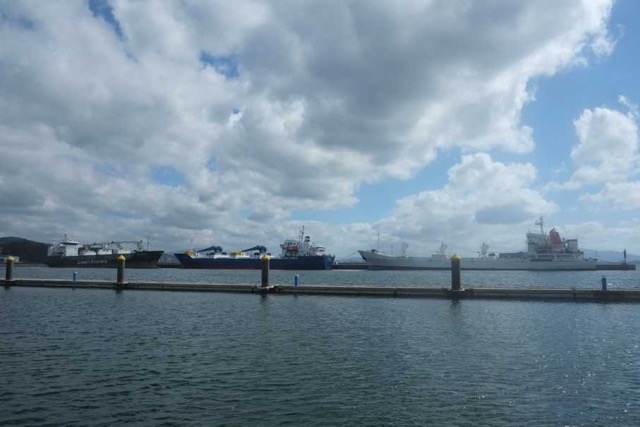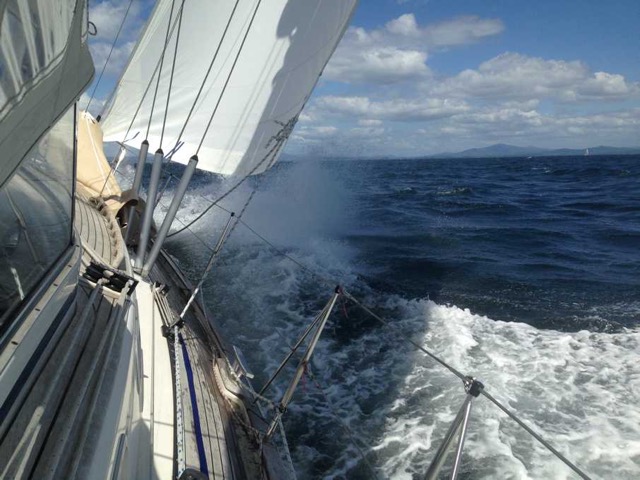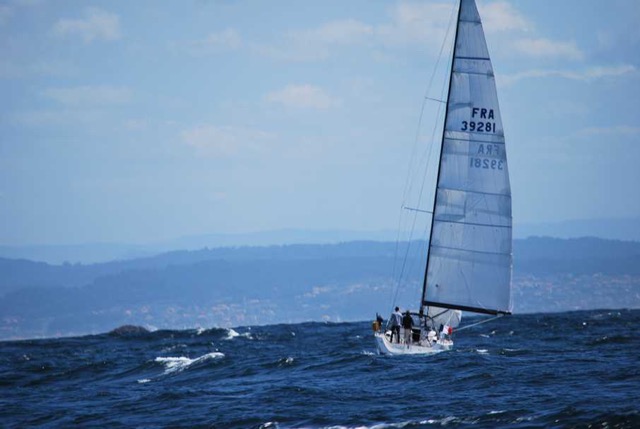A Probra do Caraminal

Vega
Hugh and Annie
Sun 9 Aug 2015 10:03
| 42:36.2N 8:56.0W We left Portosin with a forecast 4 - 5 from the north east but with a glassy smooth sea against which the Ria de Muros reflected beautifully. In fact we found the this Ria to be the most attractive so far and underestimated by the cruising guide. The shoreline towns do not dominate and the wooded hills behind provide an undeveloped and attractive backdrop - even with the wind turbines that are positioned on the hills all along the Galician coast. In fact for me they enhance the landscape by suggesting a more harmonious existence between human development and this environment without detracting from the local beauty in the slightest (an old hobby horse I know). When motoring downwind it is easy to underestimate the strength of the wind and not raise the sails as soon as they would be effective. With 10kts of wind from behind the strength is masked by the apparent wind caused by the speed of the boat under power such that it looks like motoring is still required, even though the true wind is showing 10kts on the instruments. After half an hour we realised this and then were under full sail, swishing along nicely as a coastguard helicopter swooped low overhead. We have made our peace with the authorities in Muxia and agreed to pay for the replacement of the two most expensive small plastic fenders in Europe, so were not too concerned about the helicopter checking us out. The wind rose to a steady 20kts or so but again the speed of the wind from behind is easy to underestimate when sailing - we were enjoying 7+kts before needing to gybe and change course for the Ria de Arousa. Gybing in 20kts with a well trained team of gorillas is no problem but the coordination of winding in the mainsail as you turn through the wind in a rolling sea for two puny humans has to be good. The problem is eased greatly - as is the need for winching strength - by reefing the mainsail ahead of the gybe and particularly when anticipating a more directly downwind course followed by some upwind sailing in 20kts plus of wind. So that is what we did and it worked a treat! Annie was at the helm and I was the gorilla although with the reefed main a baboon would have sufficed - and there we will end the ape analogies. During the gybe we had one or two left/right raised voice exchanges but we were soon flying along on a broad reach at 8kts. At this point Annie was really getting into the swing of things and became quite agitated that we were being overtaken by 39ft of French plastic - preferring a faster point of sail that might take us onto rocks above a slower one to give them a wider berth. The French plastic had full sail, a stern twice as wide as ours with two wheels and no transom to speak of, not really the thing for snug cruising. Turning more into the wind we flew up the Ria de Arousa and decided to anchor at the Isla de Arousa for the night and hoped for something exotic. On arrival we found a Dutch yacht at anchor, lots of moored fishing boats, as many exposed rocks and a not very pretty shoreline. Our first attempt at anchoring achieved no more than the most enormous clump of weed, silt and plastic on the anchor that took an age to prize off. The second attempt was more successful and we seemed to be holding. Annie took several bearings onto local features and we settled down to supper in the cockpit. All this time the wind had continued to blow at 20+kts and the bow was swinging wildly from side to side. After supper Annie and I were discussing how we should make things more secure for the night (I will run through anchor buddies, tripping lines etc on another occasion) including how to set maximum and minimum depth alarms when I noticed that the bow had swung more than usual. Then it became clear we we farther from the Dutch yacht than we had been and nearer the rocks behind! With no time to lose we started the engine, raised the anchor - another great wadge of weed and silt to remove - and headed off for the marina where I am now writing this piece. Other than visual there had been no indication at all that we had been dragging our anchor - something we will be much more aware of when planning a night time anchorage in future. I haven’t mentioned the Hydrovane for a while. After a flawless start it had been unable to cope with a strong wind on a port tack one evening (it is offset to port) and I feared either a fundamental problem with the positioning on the boat or a failure of the steering mechanism. I subsequently checked the steering mechanism and all seemed ok so we have subsequently used it, again with perfect results. Maybe it was just the way it was set up at the time. Anyway, I am afraid this is rather academic for the time being because yesterday in the strong wind in the marina a Spanish motor cruiser with a clearly incompetent owner was blown onto our transom and the Hydrovane took the full impact - it’s a sorry sight. After a few milliseconds of rage and despair, pots and kettles came to mind, and we had a rather frosty but cordial session tying their boat alongside and then exchanging formalities. Fortunately the young son could speak good English having spent a year at school in Norwich. Insurers have been informed and we are vacating the not so Isla de Arousa for Combarro in the next Ria. PS a mention in dispatches for anyone that can guess the cargo on the three merchant ships in the photo - they or their equivalent are here unloading all the time. Also, to those man flu jesters out there I will just say that, although granted it isn’t malaria, it does require a course of antibiotics. The only slightly suspicious part is the glee with which Annie is now able to use her carefully hoarded but past their sell by date stock of antibiotics………...     |